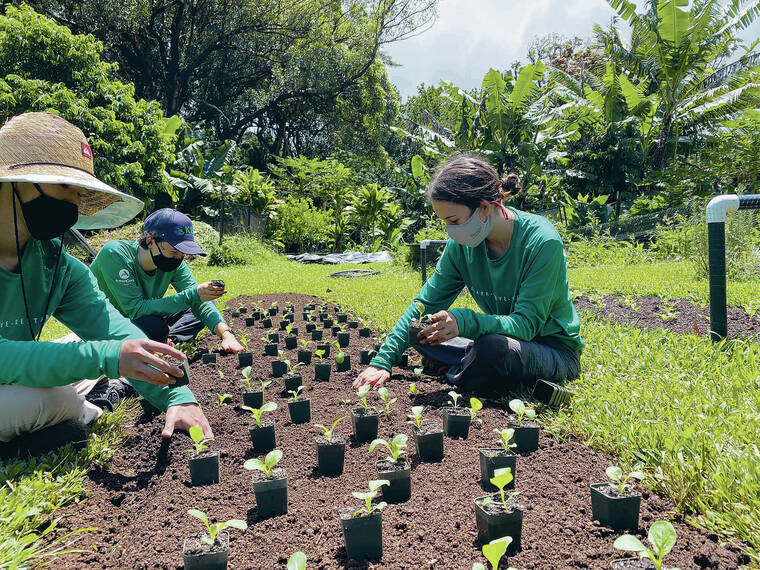After a one-year hiatus, the Hawaii Tourism Authority has brought back its grant programs that seek to support community organizations focused on protecting and perpetuating natural resources and the Hawaiian culture.
The agency, in partnership with the Hawaii Community Foundation, recently announced it had awarded more than $3 million to dozens of community groups statewide through its Kukulu Ola and Aloha ‘Aina grants.
Due to the COVID-19 pandemic, HTA said funding for both programs was cut in half in 2020 and no grants were issued in 2021.
Laura Kaakua, president and CEO of the Hawai‘i Land Trust Opens in a new tab, a recipient of Kukulu Ola and Aloha ‘Aina grants this year, said the money will support the nonprofit’s efforts to restore and steward important cultural and natural resources.
She said a $50,000 Kukulu Ola grant will be used to begin preparations to build a traditional hale on the land trust’s preserve in Hauula. The group has led stewardship and preservation efforts at its Maunawila Heiau Complex, which is home to a healing heiau.
For several years, the land trust has partnered with students and volunteers to preserve the land there. But the site lacks a formal gathering place or covered area where students and teachers can sit to talk story and learn about what they’re experiencing, she said.
That’s where the hale comes in. The land trust plans to start clearing the area and putting in parking, as well as developing community learning workshops about lashing, materials and everything needed to build a hale using traditional methods.
“For the community in Hauula, Maunawila is a source of pride and identity and a link to the past,” Kaakua said. “It’s been a really empowering process for the community to take ownership of Maunawila and see its usefulness in modern day life.”
The nonprofit plans to use its $60,000 Aloha ‘Aina grant from HTA to start restoring the Kapoho fishpond and water system at its Waihee Coastal Dunes and Wetlands Refuge on Maui.
The fishpond is unique in that it is inland and takes in a combination of river and ocean water, said Kaakua, who describes it as “a water- engineering feat.”
By restoring the fishpond and the water system, she said the trust hopes to educate people about the area’s history, provide additional habitat for endangered wetland birds and feed the community with fish and kalo.
More than 1,000 students, volunteers and visitors work the land at the Waihee refuge every year, she said. The same is true for Hawaii Land Trust’s Maunawila preserve.
Kaakua added that the Waihee project will provide better understanding of “how previous eras lived and were able to sustain themselves from the land.”
On Kauai, Nikki Cristobal, executive director and co-founder of Kamawaelualani Corp. Opens in a new tab, said a $25,000 Kukulu Ola grant from HTA will help support the nonprofit’s Mo‘olelo Murals project, which seeks to preserve and perpetuate the island’s Hawaiian culture through public art.
With the grant money, Cristobal said the organization is partnering with the YWCA Kauai to paint a mural depicting mana wahine, or powerful women, in their community.
Some of the wahine they plan to feature include kumu hula Leina‘ala Pavao Jardin of Halau Ka Lei Mokihana o Leina‘ala and kumu Sabra Kauka, a kapa practitioner.
Cristobal said the mural design is still being developed but it may incorporate images of Pavao Jardin’s dancers and Kauka’s kapa designs, which will be painted on the west- facing wall of the YWCA Kauai in Lihue.
“We kind of see it as our kuleana to celebrate the mana wahine in our community and to help educate people about this place and the fact that there are a lot of wahine here who have made our community what it is today,” she said. “The mural’s about pride in our place and trying to build community cohesion.”
Kawika Riley, senior director of external affairs at Kupu Opens in a new tab, said building and helping the community through engaging young people is one of the missions of the nonprofit’s longstanding Hawai‘i Youth Conservation Corps program. Its $50,000 Aloha ‘Aina grant will help to pay for a fraction of the program’s costs, he said.
The HYCC provides opportunities for youths to learn and work in conservation, stewardship and the environment statewide. Participants can join Kupu’s summer corps program or get involved through its community initiative in which they can learn about conservation and earn a high school diploma.
Through all of Kupu’s programs, including HYCC, Riley said the organization has trained and educated more than 5,000 youths. It’s this type of training and experience that is vital to prepare the next generation of leaders, he said.
“Young people of various walks of life have tremendous potential to be part of solving the environmental and economic challenges that we’re going through now,” Riley said. “It (Kupu’s youth programs) definitely is something that we believe contributes to this broader vision of Hawaii continuing to be a place where we can all live, and where the things that make tourism attractive — the beauty of our environment, the wonderful nature of our community — all of these things have to be nurtured.”
———
Jayna Omaye covers ethnic and cultural affairs and is a corps member of Report for America, a national service organization that places journalists in local newsrooms to report on undercovered issues and communities

